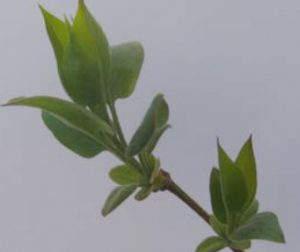Common Lilac Phenophase Definitions

Directions: As you report on phenophase status (Y, N or ?) on the datasheets, refer to the definitions on this sheet to find out what you should look for, for each phenophase in each species. To report the intensity of the phenophase, choose the best answer to the question below the phenophase, if one is included.

Leaves
Breaking leaf buds
In at least 3 locations on the plant, a breaking leaf bud is visible. A leaf bud is considered “breaking” once the widest part of the newly emerging leaf has grown beyond the ends of its opening winter bud scales, but before it has fully emerged to expose the leaf stalk (petiole) or leaf base. The leaf is distinguished by its prominent midrib and veins. (This phenophase was previously called “First leaf.”)
All leaf buds broken

For the whole plant, the widest part of a new leaf has emerged from virtually all (95-100%) of the actively growing leaf buds. (This phenophase was previously called “Full leaf out.”)
Flowers
Open flowers
For the whole plant, at least half (50%) of the flower clusters have at least one open fresh flower. The lilac flower cluster is a grouping of many, small individual flowers. (This phenophase was previously called “First bloom”.)
Full flowering

For the whole plant, virtually all (95-100%) of the flower clusters no longer have any unopened flowers, but many of the flowers are still fresh and have not withered. (This phenophase was previously called “Full bloom.”)
End of flowering
For the whole plant, virtually all (95-100%) of the flowers have withered or dried up and the floral display has ended. (This phenophase was previously called “Last bloom.”)
